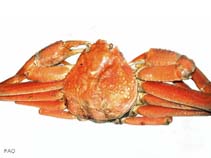Chionoecetes opilio (Fabricius, 1788)
Snow crab| Native range | All suitable habitat | Point map | Year 2050 |

|
| This map was computer-generated and has not yet been reviewed. |
| Chionoecetes opilio AquaMaps Data sources: GBIF OBIS |
Classification / Names Common names | Synonyms | CoL | ITIS | WoRMS
Malacostraca | Decapoda | Oregoniidae
Environment: milieu / climate zone / depth range / distribution range Ecology
Benthic; depth range 4 - 1400 m (Ref. 119370), usually 100 - 300 m (Ref. 117890). Boreal; -1°C - 10°C (Ref. 78815), preferred 3°C (Ref. 107945); 79°N - 29°N, 20°E - 43°W
Distribution Countries | FAO areas | Ecosystems | Occurrences | Introductions
Northern Pacific, Northern Atlantic and the Arctic. Introduced to the Northeast Atlantic (Barents Sea) and the Arctic (Kara Sea). Boreal to polar.
Length at first maturity / Size / Weight / Age
Maturity: Lm 5.0, range 5 - ? cm Max length : 13.7 cm CW male/unsexed; (Ref. 127428); max. published weight: 864.00 g (Ref. 127428)
Sediments mostly consisted of fine brown mud, either with or without nodules, pebbles and foraminiferans (Ref. 119389). Also found on sandy and gravelly bottoms (Ref. 119370). With year round temperatures 0 to 5°C (Ref. 78817). Exhibits cannibalism (Ref. 101157).
Life cycle and mating behavior Maturity | Reproduction | Spawning | Eggs | Fecundity | Larvae
Members of the order Decapoda are mostly gonochoric. Mating behavior: Precopulatory courtship ritual is common (through olfactory and tactile cues); usually indirect sperm transfer.
Main reference
References | Coordinator | Collaborators
Kon, T., T. Adachi and Y. Suzuki. 2003. (Ref. 93379)
IUCN Red List Status
(Ref. 130435: Version 2024-2)
CITES status (Ref. 108899)
Not Evaluated
CMS (Ref. 116361)
Not Evaluated
Threat to humans
Human uses
Fisheries: commercial
FAO - Fisheries: landings, species profile | FishSource | Sea Around Us
Tools
More information
Trophic Ecology
Ecology
Population dynamics
Growth
Max. ages / sizes
Length-weight rel.
Length-length rel.
Length-frequencies
Mass conversion
Recruitment
Abundance
Max. ages / sizes
Length-weight rel.
Length-length rel.
Length-frequencies
Mass conversion
Recruitment
Abundance
Life cycle
Human Related
Aquaculture profiles
Stamps, coins, misc.
Stamps, coins, misc.
Outreach
Taxonomy
References
Internet sources
BHL | BOLD Systems | CISTI | DiscoverLife | FAO(Fisheries: species profile; publication : search) | Fishipedia | GenBank (genome, nucleotide) | GloBI | Gomexsi | Google Books | Google Scholar | Google | PubMed | Tree of Life | Wikipedia (Go, Search) | Zoological Record
Estimates based on models
Preferred temperature
(Ref. 115969): 0.4 - 7.1, mean 2.9 (based on 631 cells).
Prior r = 0.58, 95% CL = 0.38 - 0.87, Based on 4 full stock assessments.
Nutrients : Calcium = 109 [35, 184] mg/100g; Iron = 1.59 [1.21, 1.97] mg/100g; Protein = 20.2 [19.2, 21.3] %; Omega3 = 0.285 [0.185, 0.386] g/100g; Selenium = 48.3 [-31.7, 128.3] μg/100g; VitaminA = 0 μg/100g; Zinc = 1.79 [1.17, 2.40] mg/100g (wet weight); based on nutrient studies.



